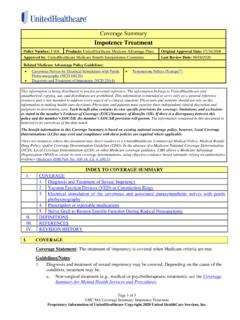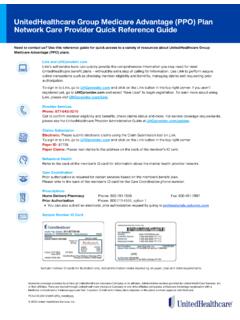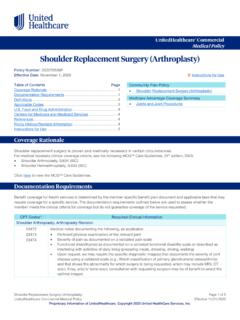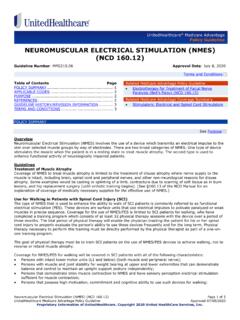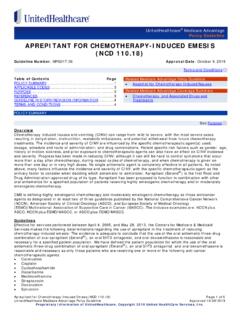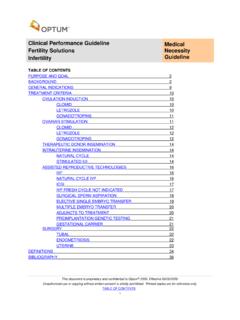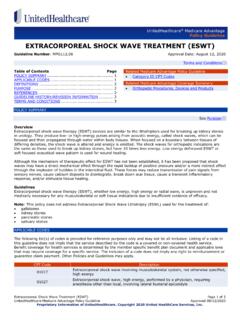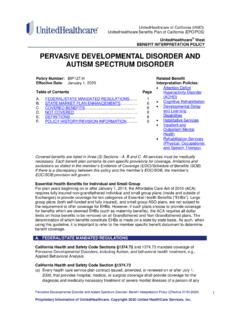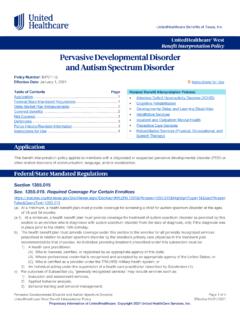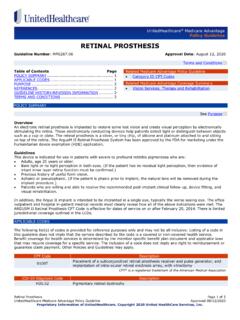Transcription of Medically Necessary Orthodontic Treatment – Dental ...
1 Medically Necessary Orthodontic Treatment Page 1 of 4 UnitedHealthcare Dental Coverage Guideline Effective 01/01/2022 Proprietary Information of UnitedHealthcare. Copyright 2022 United HealthCare Services, Inc. UnitedHealthcare Dental Cover a ge Guideline Medically Necessary Orthodontic Treatment Guideline Number: Effective Date: January 1, 2022 Instructions for Use Table of Contents Page Coverage Rationale .. 1 Definitions .. 1 Applicable Codes .. 3 Description of Services .. 3 References .. 3 Guideline History/Revision Information .. 4 Instructions for Use .. 4 Coverage Rationale Orthodontic Treatment is Medically Necessary when the following criteria have been met: The member is under the age 19 (through age 18, unless the member specific benefit plan document indicates a different age); and Services are related to the Treatment of a severe craniofacial deformity that results in a physically Handicapping Malocclusion, including but not limited to the following conditions: o Cleft Lip and/or Cleft Palate; o Crouzon Syndrome/Craniofacial Dysostosis; o Hemifacial Hypertrophy/Congenital Hemifacial Hyperplasia; o Parry-Romberg Syndrome/Progressive Hemifacial Atrophy; o Pierre-Robin Sequence/Complex; o Treacher-Collins Syndrome/Mandibulofacial Dysostosis.
2 Or o Other clinical criteria based on the member specific benefit plan document and any federal or state mandates. Removal of Fixed Orthodontics Appliances for Reasons Other Than Completion of Treatment Removal of fixed orthodontics appliances for reasons other than completion of Treatment is a decision to be made by the treating provider based on an individual patient basis. Reasons include, but are not limited to: Patient non-compliance (AAOMS) Military deployment (Department of the Army) Prior to radiation therapy to the head or neck if the appliances will be in the radiation field (NIH, AAPD) Prior to highly stomatotic chemotherapy (NIH, AAPD) Complications related to IV bisphosphonates and other medical conditions (AAOMS) Definitions Cleft Lip: A congenital facial defect of the lip due to failure of fusion of the medial and lateral nasal prominences and maxillary prominence.
3 (American Cleft Palate-Craniofacial Association) Cleft Palate: A congenital fissure in the medial line of the palate. (American Cleft Palate-Craniofacial Association) Related Medical Policy Orthognathic (Jaw) Surgery Medically Necessary Orthodontic Treatment Page 2 of 4 UnitedHealthcare Dental Coverage Guideline Effective 01/01/2022 Proprietary Information of UnitedHealthcare. Copyright 2022 United HealthCare Services, Inc. Comprehensive Orthodontic Treatment : A coordinated diagnosis and Treatment leading to the improvement of a patient's craniofacial dysfunction and/or dentofacial deformity which may include anatomical, functional and/or esthetic relationships. Treatment may utilize fixed and/or removable Orthodontic appliances and may also include functional and/or orthopedic appliances in growing and non-growing patients.
4 Adjunctive procedures to facilitate care may be required. Comprehensive orthodontics may incorporate Treatment phases focusing on specific objectives at various stages of dentofacial development. (AAO) Craniofacial Anomaly: A structural or functional abnormality that affects the cranium or face. (American Cleft Palate-Craniofacial Association) Crouzon Syndrome/Craniofacial Dysostosis: One of a large group of facial birth defects in which there is abnormal craniofacial fusion. This fusion does not allow the bones to grow normally, affecting the shape of the head, appearance of the face and the relationship of the teeth. (American Cleft Palate-Craniofacial Association) Handicap (as related to Handicapping Malocclusion): A physical, mental, or emotional condition that interferes with one's normal functioning.
5 (Farlex Partner Medical Dictionary) Hemifacial Hypertrophy/Congenital Hemifacial Hyperplasia: A rare developmental anomaly characterized by asymmetric overgrowth. Hemihyperplasia can be an isolated finding, but it also may be associated with a variety of malformation syndromes. (Neville 2016) Malocclusion (as related to Handicapping Malocclusion): A deviation in intramaxillary and/or intermaxillary relations of teeth from normal occlusion. Often associated with other dentofacial deformities. (AAO) Medically Necessary : The health care services provided for the purpose of preventing, evaluating, diagnosing or treating a sickness, injury, mental illness, substance use disorder, condition, disease or its symptoms, that are all of the following as determined by us or our designee, within our sole discretion.
6 In accordance with Generally Accepted Standards of Medical Practice. Clinically appropriate, in terms of type, frequency, extent, site and duration, and considered effective for your sickness, injury, mental illness, substance use disorder, disease or its symptoms. Not mainly for your convenience or that of your doctor or other health care provider. Not more costly than an alternative drug, service(s) or supply that is at least as likely to produce equivalent therapeutic or diagnostic results as to the diagnosis or Treatment of your Sickness, Injury, disease or symptoms. Generally Accepted Standards of Medical Practice: are standards that are based on credible scientific evidence published in peer-reviewed medical literature generally recognized by the relevant medical community, relying primarily on controlled clinical trials, or, if not available, observational studies from more than one institution that suggest a causal relationship between the service or Treatment and health outcomes.
7 If no credible scientific evidence is available, then standards that are based on Physician specialty society recommendations or professional standards of care may be considered. Parry-Romberg Syndrome/Progressive Hemifacial Atrophy: A rare disorder characterized by slowly progressive deterioration (atrophy) of the skin and soft tissues of half of the face (hemifacial atrophy), usually the left side. (National Institutes of Health) Pierre-Robin Sequence/Complex: A complex of congenital anomalies including micrognathia and abnormal smallness of the tongue, often with cleft palate, severe myopia, congenital glaucoma, and retinal detachment. (American Cleft Palate-Craniofacial Association) Treacher-Collins Syndrome/Mandibulofacial Dysostosis: The name given to a birth defect which may affect the size and shape of the ears, eyelids, cheek bones, and upper and lower jaws.
8 The extent of facial deformity varies from one affected individual to another. (American Cleft Palate-Craniofacial Association) Medically Necessary Orthodontic Treatment Page 3 of 4 UnitedHealthcare Dental Coverage Guideline Effective 01/01/2022 Proprietary Information of UnitedHealthcare. Copyright 2022 United HealthCare Services, Inc. Applicable Codes The following list(s) of procedure and/or diagnosis codes is provided for reference purposes only and may not be all inclusive. Listing of a code in this guideline does not imply that the service described by the code is a covered or non-covered health service. Benefit coverage for health services is determined by the member specific benefit plan document and applicable laws that may require coverage for a specific service.
9 The inclusion of a code does not imply any right to reimbursement or guarantee claim payment. Other Policies and Guidelines may apply. CDT Code Description D8010 Limited Orthodontic Treatment of the primary dentition D8020 Limited Orthodontic Treatment of the transitional dentition D8030 Limited Orthodontic Treatment of the adolescent dentition D8040 Limited Orthodontic Treatment of the adult dentition D8070 Comprehensive Orthodontic Treatment of the transitional dentition D8080 Comprehensive Orthodontic Treatment of the adolescent dentition D8090 Comprehensive Orthodontic Treatment of the adult dentition D8220 Fixed appliance therapy D8660 Pre- Orthodontic Treatment examination to monitor growth and development D8670 Periodic Orthodontic Treatment visit D8680 Orthodontic retention [removal of appliances, construction and placement of retainer(s)]
10 ] D8695 Removal of fixed Orthodontic appliances for reasons other than completion of Treatment D8696 repair of Orthodontic appliance maxillary D8697 repair of Orthodontic appliance mandibular D8698 re-cement or re-bond fixed retainer maxillary D8699 re-cement or re-bond fixed retainer mandibular D8701 repair of fixed retainer, includes reattachment maxillary D8702 repair of fixed retainer, includes reattachment mandibular D8703 replacement of lost or broken retainer maxillary D8704 replacement of lost or broken retainer mandibular D8999 Unspecified Orthodontic procedure, by report CDT is a registered trademark of the American Dental Association Description of Services Medically Necessary Orthodontic Treatment involves the correction of the Dental component of a craniofacial abnormality that results in a handicapping malocclusion and is intended to restore a functional dentition.
